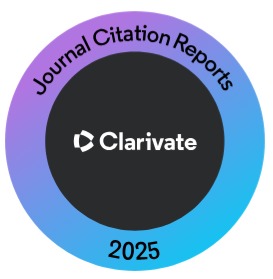Genetic Association of DPP4 C/T and GLP1R C/A with Cytokines and Hormones in Undiagnosed Diabetic Subjects
Abstract
OBJECTIVE: Genetic relationship with biochemical, hormones and markers of inflammation.
METHODOLOGY: This collaborative study was cross-sectional and carried out by the Department of
Biochemistry, Karachi University, Baqai Diabetology and Endocrinology Institute (BIDE), Karachi Pakistan and Kansai Electric Power Institute of Medical Research (KEPIIMR), Osaka-Japan. The duration of the research was from March 2019 to May 2020. Both genders aged 30-70 (years) visiting the outpatient department of BIDE and fulfilling the inclusion criteria were recruited. An oral glucose tolerance test as diagnostic criteria was used. Subjects were categorized into healthy (glucose levels of fasting glucose (FPG) less than 100 (mg/dL), a two-hour glucose post level (2-hr PGL) below 140mg/dL). Newly diagnosed diabetics (NDD) (FPG ?126mg/dL or 2-hr PGL ?200mg/dL or both without any antidiabetic medicines use). Subjects with any complications were excluded. SPSS (Social Science Package for Statistical) Version 20 was used to analyze data.
RESULTS: Of 34 subjects, 17 were NDD and 17 were healthy. The mean age was 49.65±1.95, and the
mean BMI was 28.12±0.93. DPP-4 C/T exhibited significant findings (p<0.05) compared with GLP-1R C/A among healthy and NDD subjects. Polymorphism of GLP1R C/A is associated significantly with fasting triacylglycerides and GLP1. In Comparison, polymorphism of DPP4 C/T was associated significantly in fasting with GLP1, GIP, HDL and IL-1? when compared to NDD with healthy participants.
CONCLUSION: We found significantly more association of DPP4 C/T polymorphism rs2970932 with
biochemical parameters than GLP1R C/A polymorphisms rs1042044 in NDD individuals.
References
Galicia-Garcia U, Benito-Vicente A, Jebari S, Larrea-Sebal A, Siddiqi H, Uribe KB et al. Pathophysiology of type 2 diabetes mellitus. Int J Mol Sci. 2020; 17: 6275. doi: 10.3390/ijms21176275.
Federation ID. Diabetes facts & figures. International Diabetes Federation. 2021; Available from: https://idf.org/aboutdiabetes/what-is-diabetes/facts-figures.html.
Basit A, Fawwad A, Qureshi H, Shera AS. Prevalence of diabetes, pre-diabetes and associated risk factors: second National Diabetes Survey of Pakistan (NDSP), 2016-2017. BMJ Open. 2018; 8: e020961. doi: 10.1136/bmjopen-2017-020961.
Mambiya M, Shang M, Wang Y, Li Q, Liu S, Yang L et al. The play of genes and non-genetic factors on type 2 diabetes. Front Public Health. 2019; 7: 349. doi: 10.3389/fpubh.2019.00349.
Roder PV, Wu B, Liu Y, Han W. Pancreatic regulation of glucose homeostasis. Exp Mol Med. 2016; 48: e219. doi: 10.1038/emm.2016.6.
Deacon CF. Physiology and pharmacology of DPP-4 in glucose homeostasis and the treatment of type 2 diabetes. Front Endocrinol (Lausanne). 2019; 10: 80. doi: 10.3389/fendo.2019.00080.
Boer GA, Holst JJ. Incretin hormones and type 2 diabetes—mechanistic insights and therapeutic approaches. Biology (Basel). 2020; 9: 473. doi: 10.3390/biology9120473.
Jamaluddin JL, Huri HZ, Vethakkan SR. Clinical and genetic predictors of dipeptidyl peptidase-4 inhibitor treatment response in Type 2 diabetes mellitus. Pharmacogenomics. 2016; 17(8): 867-881. doi: 10.2217/pgs-2016-0010. Epub 2016 Jun 1.
Han E, Park HS, Kwon O, Choe EY, Wang HJ, Lee YH et al. A genetic variant in GLP1R is associated with response to DPP-4 inhibitors in patients with type 2 diabetes. Medicine (Baltimore). 2016; 95(44): e5155. doi: 10.1097/MD.0000000000005155.
Meloni AR, DeYoung MB, Lowe C, Parkes DG. GLP?1 receptor activated insulin secretion from pancreatic ??cells: mechanism and glucose dependence. Diabetes Obes Metab. 2013; 15(1): 15-27. doi: 10.1111/j.1463-1326.2012.01663.x. Epub 2012 Aug 1.
Skuratovskaia DA, Vulf MA, Kirienkova MA, Myronyuk NI, Zatolokin PA, Litvinova LS. The role of LEU260PHE polymorphism of the receptor gene to GLP-1 incretin in the pathogenesis of diabetes type 2 diabetes with obesity. Diabetes mellitus 2019; 22(3): 217-224. doi: 10.14341/DM9974.
Waris N, Bano S, Fawwad A, Nazim U, and Basit A. Association of IL-6 & IL-1? (pro-inflammatory cytokines) and related biochemical indexes in newly diagnosed diabetics subjected to glucose tolerance test. Pak J Pharm Sci. 2021; 34(1): 9-14.
Hirano T. Pathophysiology of diabetic dyslipidemia. J Atheroscler Thromb. 2018; 25(9): 771-782. doi: 10.5551/jat.RV17023.
Association AD. Diagnosis. American Diabetes Association. Available from: https://diabetes.org/diabetes/a1c/diagnosis.
Miller SA, Dykes D, Polesky H. A simple salting out procedure for extracting DNA from human nucleated cells. Nucleic Acids Res. 1988; 16(3): 1215. doi: 10.1093/nar/16.3.1215.
Wangkumhang P, Chaichoompu K, Ngamphiw C, Ruangrit U, Chanprasert J, Assawamakin A et al. WASP: a Web-based Allele-Specific PCR assay designing tool for detecting SNPs and mutations. BMC Genomics. 2007; 8: 275. doi: 10.1186/1471-2164-8-275.
Godinho R, Mega C, Teixeira-de-Lemos E, Carvalho E, Teixeira F, Fernandes R et al. The place of dipeptidyl peptidase-4 inhibitors in type 2 diabetes therapeutics: a "me too" or "the special one" antidiabetic class?. J Diabetes Res. 2015; 2015: 806979.
doi: 10.1155/2015/806979. Epub 2015 May 17.
Turcot V, Tchernof A, Deshaies Y, Pérusse L, Bélisle A, Marceau P et al. Comparison of the dipeptidyl peptidase-4 gene methylation levels between severely obese subjects with and without the metabolic syndrome. Diabetol Metab Syndr. 2013; 5: 1-10.
doi: 10.1186/1758-5996-5-4.
Matsui M, Takahashi Y, Takebe N, Takahashi K, Nagasawa K, Honma H et al. Response to the dipeptidyl peptidase?4 inhibitors in J apanese patients with type 2 diabetes might be associated with a diplotype of two single nucleotide polymorphisms on the interleukin?6 promoter region under a certain level of physical activity. J Diabetes Investig. 2015; 6: 173-181. doi: 10.1111/jdi.12260. Epub 2014 Jul 25.
He X, Li W, Xie Y, Zhao Y. Long-term inhibition of dipeptidyl-peptidase 4 reduces islet infiltration and downregulates IL-1? and IL-12 in NOD mice. Int Immunopharmacol 2020; 88:106945. doi: 10.1016/j.intimp.2020.106945. Epub 2020 Sep 23.
Nasykhova YA, Tonyan ZN, Mikhailova AA, Danilova MM, Glotov AS. Pharmacogenetics of type 2 diabetes—Progress and prospects. Int J Mol Sci. 2020; 21(18): 6842. doi: 10.3390/ijms21186842.
Böhm A, Wagner R, Machicao F, Holst JJ, Gallwitz B, Stefan N et al. DPP4 gene variation affects GLP-1 secretion, insulin secretion, and glucose tolerance in humans with high body adiposity. PloS One. 2017; 12(7): e0181880. doi: 10.1371/journal.pone.0181880.
Yau AM, McLaughlin J, Maughan RJ, Gilmore W, Ashworth JJ, Evans GH. A pilot study investigating the influence of glucagon-like peptide-1 receptor single nucleotide polymorphisms on gastric emptying rate in Caucasian men. Front Physiol. 2018: 9: 1331. doi: 10.3389/fphys.2018.01331.
Sathananthan A, Man CD, Micheletto F, Zinsmeister AR, Camilleri M, Giesler PD et al. Common genetic variation in GLP1R and insulin secretion in response to exogenous GLP-1 in nondiabetic subjects: a pilot study. Diabetes Care. 2010; 33(9): 2074-6. doi: 10.2337/dc10-0200.
Lin CH, Lee YS, Huang YY, Hsieh SH, Chen ZS, Tsai CN. Polymorphisms of GLP-1 receptor gene and response to GLP-1 analogue in patients with poorly controlled type 2 diabetes. J Diabetes Res. 2015; 2015: 176949. doi: 10.1155/2015/176949. Epub 2015 Feb 15.
Downloads
Published
How to Cite
Issue
Section
License
Copyright (c) 2023 Journal of Liaquat University of Medical & Health Sciences

This work is licensed under a Creative Commons Attribution-NonCommercial-ShareAlike 4.0 International License.
Submission of a manuscript to the journal implies that all authors have read and agreed to the content of the undertaking form or the Terms and Conditions.
When an article is accepted for publication, the author(s) retain the copyright and are required to grant the publisher the right of first publication and other non-exclusive publishing rights to JLUMHS.
Articles published in the Journal of Liaquat University of Medical & health sciences are open access articles under a Creative Commons Attribution-Noncommercial - Share Alike 4.0 License. This license permits use, distribution and reproduction in any medium; provided the original work is properly cited and initial publication in this journal. This is in accordance with the BOAI definition of open access. In addition to that users are allowed to remix, tweak and build upon the work non-commercially as long as appropriate credit is given and the new creations are licensed under the identical terms. Or, in certain cases it can be stated that all articles and content there in are published under creative commons license unless stated otherwise.























